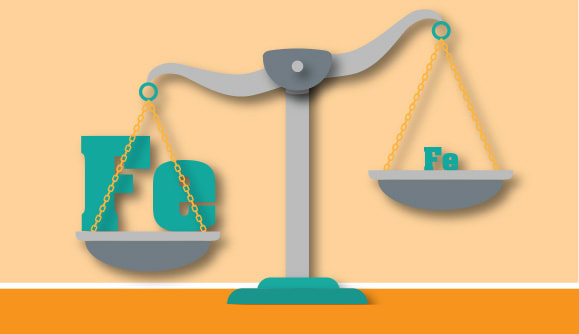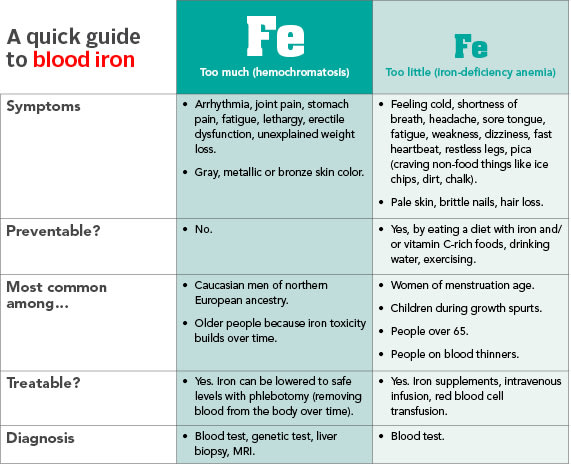Balancing act
Signs of high and low blood iron levels.

Odds are you've heard of anemia, a condition resulting from too little iron in your blood. But what about hemochromatosis, which means you have too much?
To best understand the different conditions, Sridhar Srinivasan, MD, a hematologist/oncologist at Baptist MD Anderson Cancer Center, explained how iron is normally processed in the human body.
"Iron is absorbed in the first part of the small intestine. On average, 1 milligram (mg) of iron is absorbed every day and stored in a separate compartment in the liver; the extra is excreted in urine or feces. From there, it goes into the bone marrow, where it is used in red blood cell production," he explained. "Red blood cells, and the protein called hemoglobin within them, are responsible for carrying fresh oxygen throughout the body."
Iron overload
Primary hemochromatosis (pronounced he-moe-kroe-muh-TOE-sis) is an inherited condition that causes your body to absorb and store too much iron from the food you eat. It's caused by a change (mutation) in one of the genes that control iron absorption. The condition affects nearly 1 million Americans.
"If you have this condition, the body's natural iron level sensor located in the small intestine isn't working, and more iron is absorbed. The excess iron overloads the liver and then finds its way to other organs, which can lead to damage," said Dr. Srinivasan.
Organs affected and potential health problems include:
- Liver: cirrhosis, liver cancer or liver failure
- Joints: arthritis
- Pancreas: diabetes
- Heart: arrhythmias or heart failure
- Testes: erectile dysfunction
Too much iron may also lead to skin discoloration.
Insufficient amounts
Iron-deficient anemia means the body isn't getting enough iron to power red blood cells' production of hemoglobin, so they can't carry oxygen throughout the body. In the U.S., it is the most common blood condition.
"One in six individuals will be affected in their lifetime," said Dr. Srinivasan.
The condition can be common in women – especially during menstruation or when pregnant – and children during growth spurts. However, if iron levels remain low outside of these normal times, doctors will test for underlying causes. Since it's rare for men to experience low iron, they will likely be tested for blood loss immediately.
"We treat patients with iron deficiency with supplements. If it's temporary, they will respond immediately," said Dr. Srinivasan. "If they don't respond, we want to know why. We have two possibilities: undiagnosed blood loss or an absorption problem, such as celiac disease."
Further testing can help define the possible cause.
Untreated anemia could lead to chronic fatigue, loss of productivity, increased heartbeat, enlarged heart or heart failure.
Not too late
The good news is, when caught early, both conditions are treatable. Doctors usually won't test for either condition unless your symptoms guide them to.
If you're a parent and are diagnosed with hemochromatosis (or know of a family history of it), Dr. Srinivasan suggested your spouse and close family members get tested to determine the likelihood of having passed the gene on to children. The primary goal of this testing is to detect, treat or monitor hereditary hemochromatosis before there are complications.
As always, talk with your primary care physician or your child's pediatrician about any symptoms you or your child may be having.

If you have health questions, Baptist Primary Care physicians and pediatricians are ready to answer them! To find the right doctor for your family, call 904.202.4968 or request an appointment.



